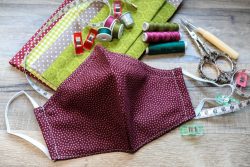 During the beginning of the COVID-19 Pandemic CDC recommends people wear face masks when in public. Due to the shortage of N95 and surgical masks, they have recommended people make their own coverings. Some materials can filter out particles much better than others, significantly affecting how well a homemade face mask may protect a person from the virus.
During the beginning of the COVID-19 Pandemic CDC recommends people wear face masks when in public. Due to the shortage of N95 and surgical masks, they have recommended people make their own coverings. Some materials can filter out particles much better than others, significantly affecting how well a homemade face mask may protect a person from the virus.
The COVID-19 virus is believed to be spread mainly from respiratory droplets from a person that’s been infected speaks, breathes, coughs or sneezes. The droplets are all different sizes, however the tiniest ones, which are called aerosols can slip through any openings that are between a variety of cloth fibers. This has lead to some people questioning as to whether cloth masks can really help fight disease.
Supratik Guha at the Univ. of Chicago and colleagues set out to study if common fabrics by themselves or in a combination have the ability to filter out aerosols in relation in size to respiratory droplets.
The team used an aerosol mixing device to create particles that range from 10nm to 6um in diameter. A fan was used to blow the aerosol across a variety of cloth samples at an airflow rate similar to a person’s respiration at rest. The team then measured the size and number of particles in air before and following passing through the fabrics.
Tightly woven cloth in one layer along with 2 layers of polyester-spandex chiffon which is a sheer fabric, filtered out most of the aerosol particles ((80-99%) depending on the size of the particle with results close to that of an N95 mask.
They then substituted using natural silk or flannel or just using cotton quilt with cotton-polyester batting which had similar results. The team has pointed out that tightly woven fabrics like cotton man act as a mechanical border to particles. Fabrics that hold a static charge such as natural silk and chiffon act as an electrostatic barrier.
Researchers are reporting that a combination of cotton with either natural silk or chiffon can effectively filter out aerosol particles if the fit is good. You can also use doubled up 600 thread count pillowcases or flannel pajamas or cotton T-shirts which will make a mask that will provide up to 60% filtration. Other materials that can be used to filter our dangerous particles include vacuum cleaner bags, HEPA filters, and quilter’s cotton. You do want to be careful of materials like household air filters that many contain fiberglass which can damage the lungs even if they filter out particles.
To view the original scientific study click below
Aerosol Filtration Efficiency of Common Fabrics Used in Respiratory Cloth Masks.





